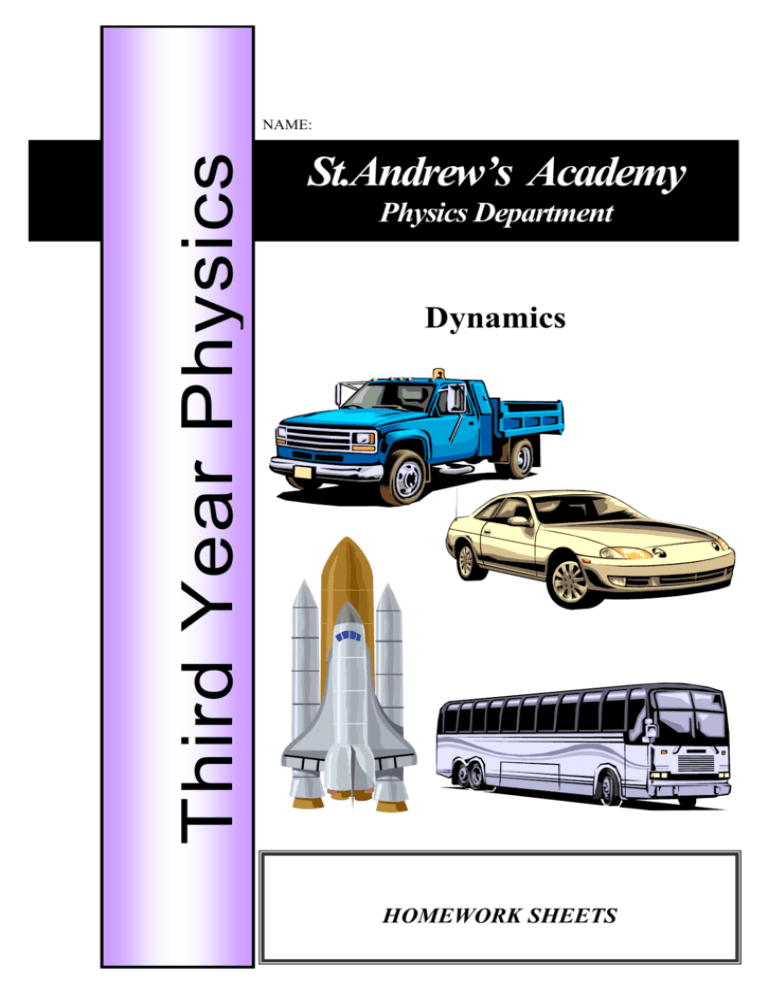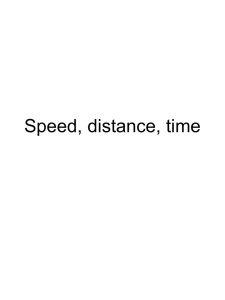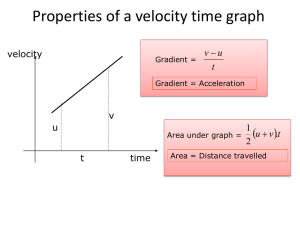dynamics
advertisement

Third Year Physics NAME: St.Andrew’s Academy Physics Department Dynamics HOMEWORK SHEETS DYNAMICS HOMEWORK 1 1. A car is travelling at a constant speed of 25ms-1. How far will it travel in 5 seconds? 2. A train travels a distance of 600m in a time of 30s. Calculate its average speed 3. How long will it take a car travelling at 40ms-1 to travel a distance of 800m? 4. The following is an extract from a train timetable Station Time Glasgow (departs) Paisley Johnstone Kilwinning Ayr 09.40 09.55 10.00 10.20 10.45 Distance from Glasgow (m) 0 9km 11km 20km 39km (a) How long does it take the train to travel from Glasgow to Paisley (b) Calculate the average speed of the train between Glasgow and Paisley in metres per second (c) How long does it take the train to travel from Glasgow to Ayr (d) Hence calculate the average speed of the train between Glasgow and Ayr in metres per second 5. A car runs down a runway as shown light gate A timer Karen wants to find the instantaneous speed of the car at point A State what measurement she needs and explain how she would use them to find the speed at A 6. A car starts from rest and runs down a runway from X to Y light gate X Y stopclock timer Length of runway from X to Y = 1.5m Length of card on car = 0.04m Time to travel from X to Y = 20s time on timer = 0.67s (a) Calculate the average speed of the car as it travels down the runway (b) Calculate the instantaneous speed of the car as it passes point Y DYNAMICS HOMEWORK 2 1. A car accelerates down a slope at 3ms-2. What does this mean? 2.A car accelerates from rest to a speed of 40ms-1 in a time of 8s. Calculate its acceleration 3.A motorbike accelerates from 2ms-1 to 8ms-1 in a time of 4s. Calculate the acceleration 4. A coach travelling at 40ms-1 slows down to a speed of 10ms-1 in a time of 5s. Calculate the acceleration 5. The table below shows the performance for 5 different cars Car Maximum speed Micra Metro Uno Nova Panda 40 38 42 36 34 (a) (b) (c) (d) Time taken to change from 0 to 20ms-1 8 7.5 8.2 10 12 Which car has greatest maximum speed Which car has greatest acceleration Which car has least acceleration Calculate the acceleration of the Micra 6. A car accelerates from rest with an acceleration of 5ms-2. Calculate its speed after 7 seconds. 7. A train is travelling at 5ms-1. It then accelerates at 2ms-2. Calculate its speed 4seconds later 8. An aeroplane accelerates at a rate of 20ms-2 reaching a speed of 200ms-2 after 5seconds. Calculate its initial speed DYNAMICS HOMEWORK 3 Distance travelled = area under graph 1. The following graph represents the motion of a train. Speed/m/s B 40 C 30 20 10 D A 10 20 30 40 50 Time/s (a) Describe the motion of the train between (i) A and B (ii) B and C (iii) C and D (b) Calculate the acceleration of the train between (i) A and B (ii) C and D (c) Calculate the distance travelled by the train in 50seconds 2 A hot air balloon is released and it accelerates upwards. During the ascent, some sandbags are released and the acceleration increases. The graph shows its vertical motion during the first 50 seconds of its flight. Speed/ms-1 8 6 4 2 10 20 30 40 50 Time/s (a) Calculate the acceleration between (i) 0 and 30s (ii) 30s and 50s. (b) How high had the balloon risen after the 50 seconds had passed? 3. A car on a motorway is travelling at 40ms-1. The driver notices a sign ahead that tells him to slow down to 30ms-1. The driver takes 8 seconds to slow down (a) Draw a graph of the motion of the car from the moment the driver sees the sign (b) Calculate the acceleration of the car (c) The driver started to decelerate when he was 250m from the sign. Would he have reduced his speed to 30ms-1 before reaching the sign? DYNAMICS HOMEWORK 4 1. What is the difference between mass and weight 2. What is meant by gravitational field strength 3.The table below gives the gravitational field strength for the other planets in our solar system. Using information in this table, answer the questions. PLANET Mercury Venus Mars Jupiter Saturn Uranus Neptune Pluto G(N/kg) 3.7 8.8 3.8 26.4 11.5 11.7 11.8 4.2 (a) Find the weight of a 60 kg man on Mercury. (b) Find the weight of a 40 kg girl on Saturn. (c) Find the mass of a woman who weighs 1188 N on Jupiter. (d) Find the mass of a cat that weighs 6.3 N on Pluto. 4. A 1000kg space buggy is taken to the Moon where the gravitational field strength is 1.6Nkg-1. (a) What is the mass of the buggy on the Moon (b) What is the weight of the buggy on the Moon 5. (a) How does the direction of the force of friction relate to the direction of a vehicle’s motion? (b) What type of energy is produced whenever a moving object meets friction? (c) State an example of where friction is helpful and we try to increase it. (d) Give an example where we try to reduce friction as much as possible. 6. What happens to the force of friction as the speed of an object increases. 7. What word is used to describe the forces shown below 20N 20N 8. An object is being pulled at a constant speed of 4ms-1 by a force of 30N. What is the force of friction acting on the object 9. Explain how a seat belt can prevent serious injuries in a car crash. DYNAMICS HOMEWORK 5 1. (a) A boy of mass 45 kg slides down a chute at a leisure centre. His acceleration is initially 2ms-2. Find the force acting on him. (b) A car's engine applies a force of 3000 N, causing the car to accelerate at 4ms-2. Calculate the mass of the car. 2. The diagram below illustrates the forces acting on a motorbike. The combined mass of the bike and rider is 125 kg. 200 N 700 N (a) Calculate the resultant force acting on the bike. (b) Calculate the acceleration of the bike. 3. A skydiver of mass 60kg falls from an aeroplane. At some time during his fall the air resistance amounts to 200N. (a) Draw a diagram showing the forces acting on the skydiver (b) Calculate the unbalanced force (c) Hence calculate the acceleration 4. A fisherman of mass 70kg is rescued from a ship by helicopter as shown (a) Calculate the fisherman’s weight (b) What force is required to lift the man at a constant speed (c) The lifting force is now increased to 910 N. Draw a diagram of the man showing the forces acting on him (c) Calculate the unbalanced force acting on the man (d) Hence calculate the acceleration 5. A rocket of mass 5000kg lifts off from the Earth with an acceleration of 20ms-2 (a) Draw a diagram showing the forces acting on the rocket (b) Calculate the unbalanced force (c) Hence calculate the thrust from the engine 6. In terms of Newton’s third law explain why the rocket lifts off from Earth. DYNAMICS HOMEWORK 6 1. In each of the cases below, state the main energy change involved for the vehicle. (a) A rollercoaster carriage rolling up a slope to a high point. (b) A skier skiing down a slope. (c) A bus driving along a level road at a constant speed. 2. (a) Calculate the work done by a horse when it uses a force of 800 N to pull a sled a distance of 150 m. 3. A train gains 50000J of energy over a distance of 200m. Calculate the average unbalanced force pulling it 4.A roller coaster carriage has a mass of 300 kg when it is carrying a full load. (a) Calculate the potential energy of the carriage when it is at the top of a drop, 30 m above the ground. (b) At the bottom of the drop it is at a height of 2 m above the ground. Calculate its potential energy now. (c) Calculate how much kinetic energy the carriage will have at this point. 5.A box of mass 2kg is lifted through a height of 8m. Calculate the gain in potential energy of the box 6. An electric motor lifts a 50kg mass through a height of 20m in a time of 30s (a) Calculate the gain in potential energy (b) Calculate the power of the motor (c) Why in practice is more power required than this 7. A box is pulled up with a force of 2000N by means of an electric motor. The box is raised through a height of 20m in 50s. (a) Calculate the energy gained by the box (b) Calculate the power of the motor 8. In terms of Newton’s third law explain why a water rocket lifts off. DYNAMICS HOMEWORK 7 1. Calculate the kinetic energy of a car of mass 600kg travelling at 5ms-1 2. A lorry of mass 800kg has kinetic energy of 160000J. Calculate the mass of the lorry 3. A ball of mass 3kg is dropped from a height of 5m and hits the ground. (a) Calculate the loss in potential energy (b) How much kinetic energy will it have as it hits the ground (c) Calculate the speed of the ball on hitting the ground 4. A trolley of mass 2kg is given a push up a ramp at 8ms-1 (a) Calculate the kinetic energy of the trolley (b) Calculate the height reached by the trolley (c) Why in practice will the trolley not reach this height 5. A car is acted upon by a force of 400N and a speed time graph is drawn of the motion as shown Speed ms-1 40 Time/s 8s (a) Calculate the distance travelled by the car in 8s (b) Calculate the work done by the engine in this time (c) Calculate the power of the engine 6. Read this passage on Thinking and Braking and then answer the questions that follow it. You are travelling at 30 mph in a car in good road conditions when you suddenly see children crossing the road. By the time you react and apply the brakes, the car has travelled a total distance of 23 m. If the car had been travelling at 60 mph the stopping distance would have been 73 m. The stopping distance consists of two parts: the thinking distance and the braking distance. The thinking distance is the distance travelled in the time between seeing a hazard on the road and pressing the brake pedal. This time is called the reaction time. thinking distance = speed x reaction time Reaction times vary from person to person. An average driver has a reaction time of about 0.8 seconds. A professional racing driver has a reaction time of about 0.2 seconds. Your reaction time is likely to be much longer if you have taken drugs or alcohol. Even a small amount of alcohol can greatly increase your reaction time. (a) What is meant by the term ' thinking distance'? (b) What will happen to the thinking distance if the car is going faster? (d) If a car is going faster will the reaction time alter? Explain your answer. (e) A driver with a reaction time of 0.5s and travelling at 25ms-1 applies his brakes suddenly. How far will the car travel during the driver’s reaction time (f) What factors affect your reaction time (g) What factors affect the braking distance








